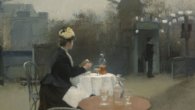
The textile, protagonist of the new exhibition of memory windows
Each fabric, in its most diverse forms, intertwines many lives: those of those who worked in the factories and those who decided how they worked, those of the artists and artisans who created new designs and applications to create more comfortable spaces, as well as those that could enjoy it in their daily lives. This Friday May 9 at 7pm We will open Textile plots. Subject, capital and workan exposure to the care of Marta Dahó In the frame of Memory windowsthat can be visited Until July 26.
The exhibition indicates that The creation of the Eixample isin many ways, indissolibly linked to textile industrializationkey area in the modernization of Catalonia and in the same gestation of this urban planning project. On the one hand, some of the most sophisticated households in the Eixample belonged to large textile businessmen, who were also promoting the creation of this and great patrons of Modernism. On the other hand, in the factories of the Barcelona periphery the labor work was subject to conditions of great precariousness, which allowed a large accumulation of capital for the benefit of their owners.

What can the interior of a home tell us about a city? And, above all, what stories unfold when we ask ourselves for the objects and subjects that have accompanied gestures, ways of doing and living? Textile plots. Subject, capital and work also try to approach the Eixample interiors material story through the presence of the tissue. Because in the microcosm that each home forms we can always find the traces of the historical processes, as well as the imprints of the work of those who shaped the elements that make up the interior of a house.
From the dialogue with the sculptures by Paula García-Masedothat the artist has created on the occasion of this project, the exhibition is articulated through a selection of photos from photo background Memory windows and other public archives, in order to address often invisible aspects and to reconnect split bonds of the social memory associated with the Eixample.
The sculptural work of Paula García-Masedo has been characterized, for several years, by the use of textile fibers such as linen. For this exhibition he has also incorporated cotton in order to reflect on the linking of these materials with the industrial development of Barcelona and the same configuration of the Eixample.
Textile plots. Subject, capital and work is part of Memory windowsthe project of the Casa Elizalde for Recover the visual memory of the Eixample territory And it is built from the digitalization of photographs of the family archives of neighbors of the Eixample. The fund, in constant growth, forms a collective and neighborhood memory of this district and, by extension, of the city of Barcelona.

Complementary activities
Wednesday, June 11 at 7 pm
Commented visit to the exhibition
By Marta Dahócurator of the exhibition.
Friday, June 13 at 11 am
Interview with archival material
By Matteo guidartist and anthropologist.
Monday, June 16 at 7pm
Double projection ‘The narratives of work’ and ‘fictions amphibias’
With colloquium in charge of María Ruido.
Wednesday, June 18 at 7pm
Commented visit to the exhibition
By Marta Dahócurator of the exhibition.
Monday, June 30 at 7.30 pm
Textiles, paper and prey. A cultural ecology of hydraulic capitalism in southern Europe
Conference by Jaime VindelEuropean Doctor in Art History.
*Cover photography: Salon Dorado Luis XVI1919. Courtesy: Carme Solé. Memory windows.







